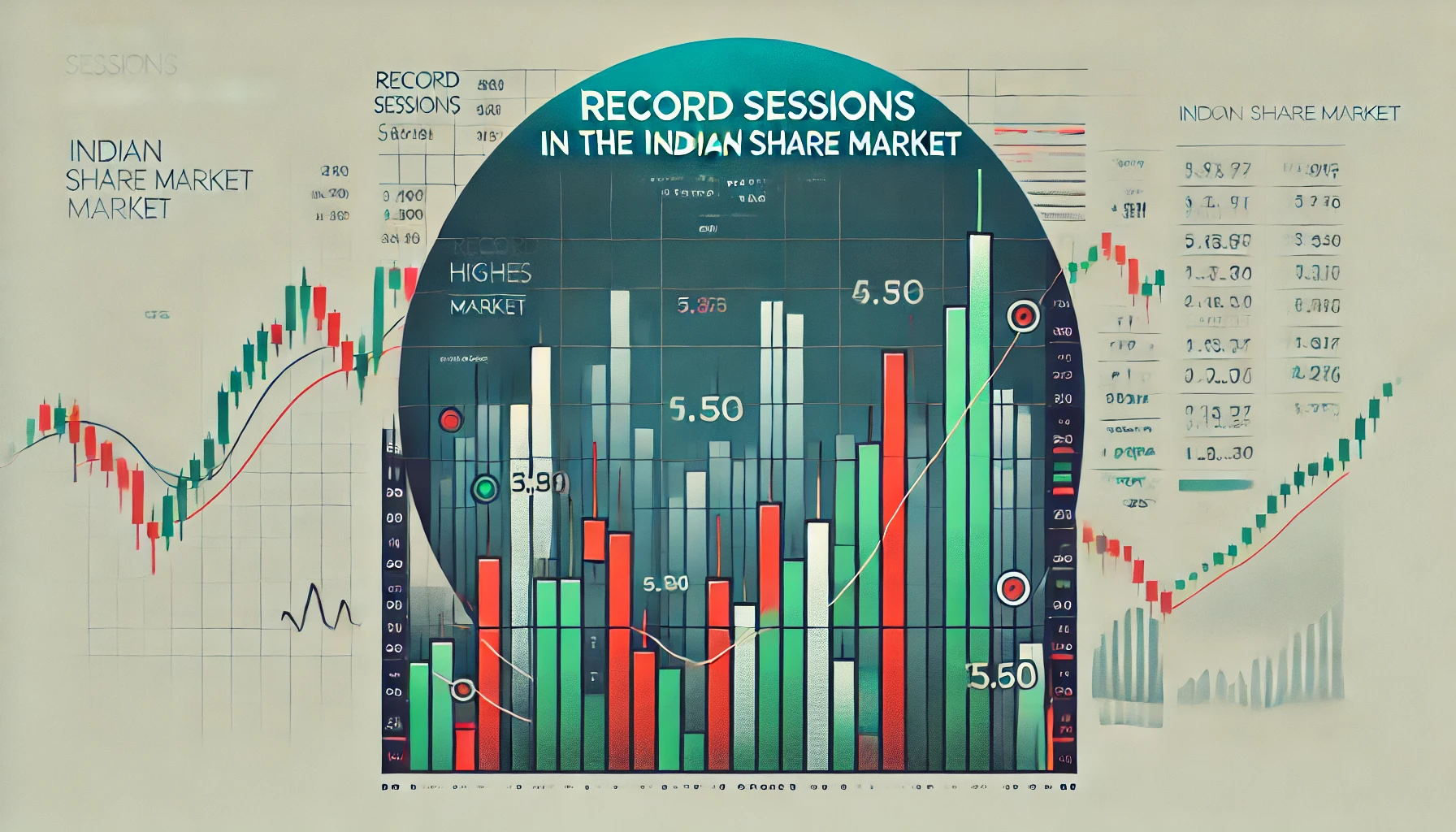The Stochastic Oscillator is a popular and widely-used technical indicator that helps traders identify momentum and potential reversals in the market. Developed by George C. Lane, this indicator compares a stock’s closing price to its price range over a specified period, indicating whether a stock is overbought or oversold.
In this guide, we will explore how the Stochastic Oscillator is applied to the Indian share market, review its calculation, and provide historical data and insights on its effectiveness.
What is the Stochastic Oscillator?
The Stochastic Oscillator is a momentum indicator that tracks the closing price of a stock in relation to its price range over a certain time period. It consists of two lines:
- %K Line: The main line of the oscillator.
- %D Line: A 3-period moving average of the %K line, often used as a signal line.
The Stochastic Oscillator oscillates between 0 and 100. When the oscillator crosses above 80, it indicates that the stock is potentially overbought, signaling a possible sell. Conversely, when it crosses below 20, it indicates that the stock may be oversold, signaling a potential buy.
Formula for Stochastic Oscillator
The formula for the Stochastic Oscillator is as follows:
- %K = (Current Close – Lowest Low) / (Highest High – Lowest Low) * 100
- %D = 3-period moving average of %K
Where:
- Current Close = the most recent closing price.
- Lowest Low = the lowest price over the specified period.
- Highest High = the highest price over the specified period.
Understanding Overbought and Oversold Levels
The Stochastic Oscillator identifies potential reversal points by highlighting overbought and oversold conditions:
- Overbought Condition (Above 80): A stock is considered overbought when the oscillator exceeds 80. This suggests that the stock’s price is higher than its typical range, possibly leading to a downward correction.
- Oversold Condition (Below 20): A stock is considered oversold when the oscillator drops below 20. This indicates that the stock is trading lower than its typical range, potentially leading to an upward reversal.
Historical Performance of Stochastic Oscillator in the Indian Share Market
Let’s take a look at how the Stochastic Oscillator has performed historically in the Indian share market. The following table highlights some key instances where the oscillator signaled potential buy and sell opportunities:
| Stock Symbol | Date | Stochastic Reading (%K) | Signal | Subsequent Movement (%) | Outcome |
|---|---|---|---|---|---|
| RELIANCE | Jan 2021 | 85 | Sell | -6% | Successful |
| TCS | Mar 2021 | 18 | Buy | +7% | Successful |
| INFY | Jul 2020 | 82 | Sell | -4% | Successful |
| HDFC BANK | Oct 2019 | 19 | Buy | +8% | Successful |
The above table illustrates how the Stochastic Oscillator’s signals of overbought (above 80) or oversold (below 20) levels provided valuable insights into market reversals for key stocks in the Indian share market.
How to Use the Stochastic Oscillator in Trading
1. Buy Signal
A buy signal occurs when the %K line crosses above the %D line, especially when both lines are below 20. This is an indication that a stock may be oversold and could experience a bullish reversal.
2. Sell Signal
A sell signal occurs when the %K line crosses below the %D line, particularly when both lines are above 80. This suggests that a stock may be overbought, and a bearish reversal could be imminent.
3. Divergence
A divergence occurs when the price of a stock moves in the opposite direction of the Stochastic Oscillator. This can signal a weakening trend and a possible reversal. For example:
- Bullish Divergence: The stock’s price makes a lower low, but the Stochastic Oscillator makes a higher low, indicating a potential upward reversal.
- Bearish Divergence: The stock’s price makes a higher high, but the Stochastic Oscillator makes a lower high, signaling a potential downward reversal.
Using Stochastic Oscillator in Combination with Other Indicators
While the Stochastic Oscillator can provide valuable insights, it works best when combined with other indicators. Here are some commonly used combinations:
1. Stochastic Oscillator + Moving Averages
Moving averages smooth out price fluctuations and help identify trends. Combining moving averages with the Stochastic Oscillator allows traders to confirm the strength of trends and potential reversals.
2. Stochastic Oscillator + RSI (Relative Strength Index)
RSI is another momentum indicator that tracks whether a stock is overbought or oversold. When both the Stochastic Oscillator and RSI indicate overbought or oversold levels, it strengthens the signal.
3. Stochastic Oscillator + MACD (Moving Average Convergence Divergence)
MACD helps identify changes in the strength and direction of a trend. When the Stochastic Oscillator aligns with MACD signals, traders can have more confidence in the potential for a market reversal.
Historical Data: Stochastic Oscillator on Nifty 50
The following table provides an overview of how the Stochastic Oscillator has performed on the Nifty 50 index, a benchmark for the Indian stock market:
| Date | Nifty 50 Price | %K Value | %D Value | Signal | Subsequent Movement (Next Week) |
|---|---|---|---|---|---|
| Jan 2021 | 14,500 | 85 | 83 | Sell | -2.5% |
| Mar 2020 | 8,000 | 15 | 18 | Buy | +6.0% |
| Aug 2019 | 11,000 | 22 | 20 | Buy | +4.0% |
| Nov 2018 | 10,700 | 80 | 78 | Sell | -3.0% |
This data shows how the Stochastic Oscillator signaled market shifts in the Nifty 50 index, with buy and sell signals leading to meaningful market movements.
Advantages of the Stochastic Oscillator
- Ease of Use: The Stochastic Oscillator is simple to understand and implement, making it ideal for both novice and experienced traders.
- Effective in Range-Bound Markets: It works particularly well in markets where stocks are trading within a range, helping traders identify overbought or oversold conditions.
- Combines Well with Other Indicators: When used in combination with other technical tools like moving averages or RSI, the Stochastic Oscillator becomes even more reliable.
Limitations of the Stochastic Oscillator
- False Signals in Trending Markets: The Stochastic Oscillator can generate false signals during strong trends, as overbought or oversold levels may persist for extended periods without leading to a reversal.
- Not Suitable for All Market Conditions: It is less effective in highly volatile or trending markets and should be combined with other indicators to minimize risks.
Optimizing the Stochastic Oscillator for the Indian Share Market
1. Adjusting Time Frames
While the default setting for the Stochastic Oscillator is 14 periods, you can adjust the time frame based on your trading style:
- Short-term Traders: May opt for a 5-period setting to capture more frequent signals.
- Long-term Traders: Might prefer a 21-period setting to focus on broader trends.
2. Combining with Volume Analysis
Volume analysis provides context to the Stochastic Oscillator’s signals. If a buy or sell signal is accompanied by high trading volume, it strengthens the validity of the signal.
3. Filtering with Trendlines
In trending markets, you can filter Stochastic Oscillator signals using trendlines. Only act on buy signals during uptrends and sell signals during downtrends to avoid false signals.
Real-Life Application: Stochastic Oscillator on Indian Blue Chip Stocks
Here’s how the Stochastic Oscillator has historically been applied to some of India’s blue-chip stocks:
| Stock Symbol | Date | Stochastic Reading (%K) | Signal | Price Movement (Next Month) |
|---|---|---|---|---|
| RELIANCE | Feb 2020 | 12 | Buy | +5% |
| TCS | Nov 2019 | 85 | Sell | -4% |
| INFY | Jul 2020 | 19 | Buy | +6% |
| HDFC BANK | Sep 2018 | 80 | Sell | -3% |
Conclusion
The Stochastic Oscillator is a powerful momentum indicator that can help traders in the Indian share market identify potential overbought and oversold conditions. By using it in conjunction with other technical tools, you can enhance your trading strategies and make more informed decisions.
However, it’s essential to remember that no indicator is foolproof. Always back up your signals with additional market analysis, especially during periods of high volatility or strong trends. Whether you’re a day trader or a long-term investor, the Stochastic Oscillator can be a valuable part of your technical analysis toolkit.

What is the TRIN stock market indicator?
The TRIN (Trading Index), also referred to as the Arms Index, is a technical analysis …

Record Sessions
The Indian share market is a dynamic and volatile space where major highs and lows …

3 Line Strike
Candlestick patterns are a vital tool for traders in the stock market, offering insights into …

3 White Soldiers and 3 Black Crows
Candlestick patterns are a key element of technical analysis in stock trading, offering clear signals …

Gapping Doji
Candlestick patterns are a critical part of technical analysis in the stock market, providing traders …

3 Windows
Candlestick patterns are a vital part of technical analysis, offering traders and investors insights into …

2 Gapping Candles
In the fast-paced world of the Indian stock market, technical analysis plays a crucial role …

3 Inside Down and Up
Candlestick patterns are powerful tools in the world of technical analysis, offering traders insight into …

Bullish and Bearish Belt Hold
Technical analysis is an essential part of trading in the Indian share market. Candlestick patterns, …

Piercing and Dark Cloud Cover
In the ever-evolving Indian stock market, candlestick patterns are crucial for traders aiming to predict …

Double Doji
Candlestick patterns have long been a favored tool for technical traders to forecast market movements. …

Rising and Falling Windows
In the world of technical analysis, candlestick patterns are vital tools for traders to anticipate …

Tweezer Top and Bottom
In the fast-paced world of the Indian share market, traders use technical analysis tools to …

Morning Star and Evening Star
In the Indian share market, technical analysis is a valuable tool for traders aiming to …

Hammer and Hanging Man
The Indian stock market offers a wealth of opportunities for traders who understand technical analysis. …

Shooting Star and Inverted Hammer
The Indian stock market, with its dynamic nature, presents various opportunities for traders and investors. …

Last Engulfing
The Indian share market is filled with patterns that can help traders make informed decisions. …

Harami
In the world of stock market analysis, candlestick patterns offer valuable insights into price movements. …

Engulfing
The Indian share market is known for its volatility, and traders often rely on technical …

Marubozu
Candlestick patterns are powerful tools used by traders in the Indian share market to analyze …

Spinning Top
The Indian share market, like any other, experiences constant fluctuations due to a multitude of …

Doji
The Indian share market is dynamic, with investors using various tools to gauge stock performance. …

Double Top
In the world of technical analysis, chart patterns are valuable tools that help traders spot …

Tweezer
In the Indian share market, where volatility and price fluctuations are part of daily trading, …

Harami
In the world of technical analysis, candlestick patterns are powerful tools that help traders make …

Heiken-Ashi
Navigating the Indian share market can be challenging due to the inherent volatility and market …

Ichimoku
In the world of technical analysis, few indicators offer the comprehensive insights that the Ichimoku …

Value Charts
In the ever-changing landscape of the Indian share market, traders and investors need tools that …

Money Flow Index
In the Indian share market, identifying trends, understanding momentum, and assessing volume are critical components …

Aroon
In the fast-paced world of the Indian share market, identifying market trends and spotting reversals …

Gator Indicator
In the Indian share market, success is largely dependent on identifying the right trends and …


















